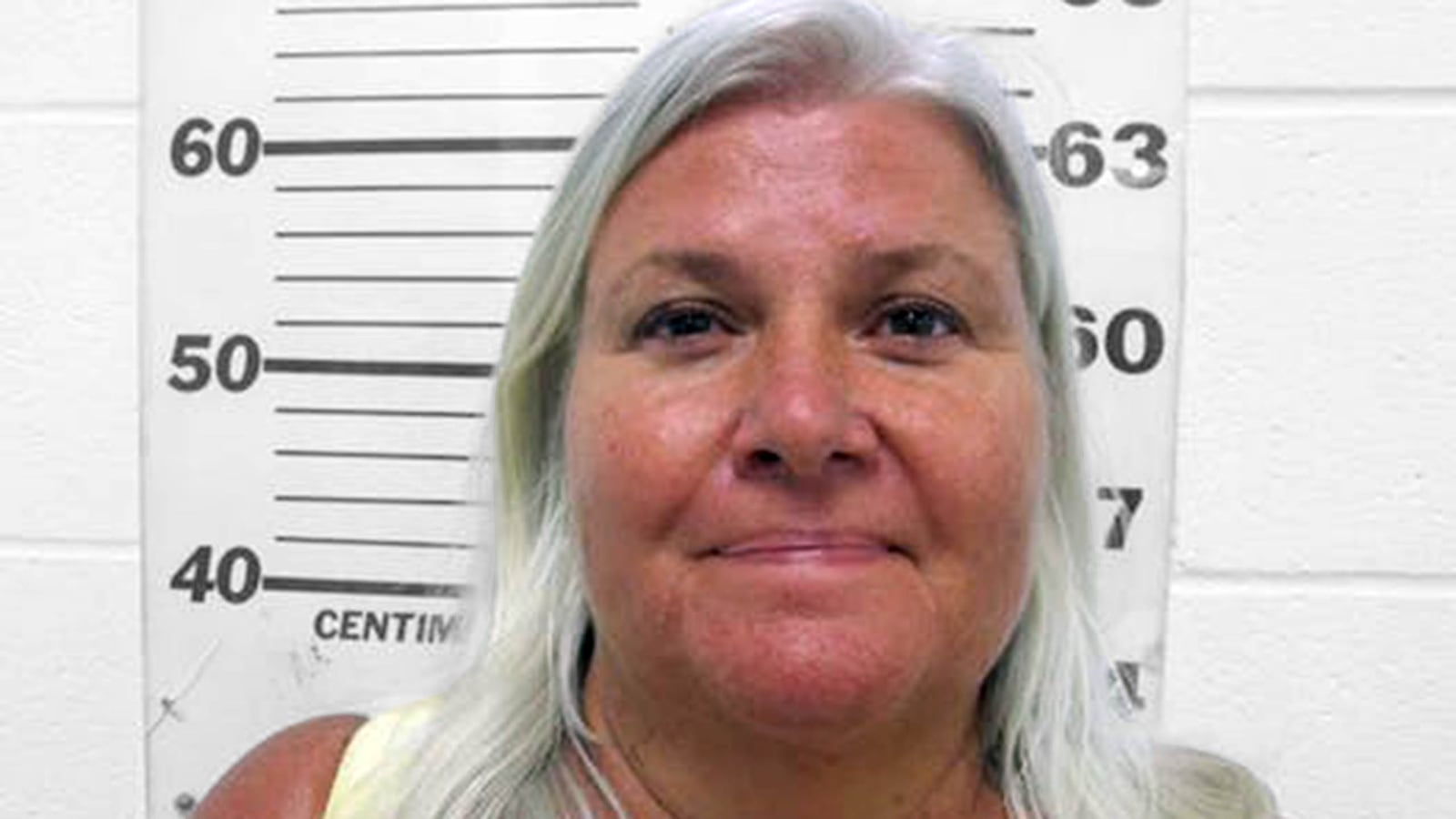Just before she was arrested, newspapers named Lois Ann Riess – the Minnesota woman suspected of murdering her husband and doppelganger – the “Grandma Killer.” All told, Riess fits the bill: the 56-year-old retiree has grey-hair, seven grandkids, a thing for sun hats, and a warm, nurturing vibe – based, at least, on the surveillance footage authorities gathered from her five weeks on the lam.
But authorities allege that the former daycare provider is an ex-fugitive with a gambling problem, who fatally shot her husband at their Minnesota worm farm, fled across the country under the alias Stormy Liberty, befriended a lookalike to steal her identity, and then killed her in a beachside timeshare.
Riess appeared this week in a Florida courtroom, the latest step in criminal proceedings that could put her in a place few women end up: death row. The court session was brief. Her defense attorney asked for extra time to schedule depositions. And the defendant, Lois Ann Riess, was present for just a few minutes before deputies led her back to jail.
Riess has pleaded not guilty to first-degree murder and other charges, but prosecutors have amassed a mountain of evidence against her. The case file contains 2,600 pages of discovery material, including more than 800 photos of Riess’ time on the run; nearly three dozen witnesses; and a montage of surveillance video identifying the woman in several states — pieces of a narrative that shapes into one of the stranger crimes of the year.
The story of Lois Ann Riess starts in Blooming Prairie, a very pretty, very tiny town in the southeast corner of Minnesota, where she lived with her husband, David, and their three kids: Bill, Braden, and Bria. Blooming Prairie is the picture of the middle-American hamlet — its slogan: “A Great Place to Spend the Next 100 Years”— with an old historic district, a Dairy Queen, and a whole section of the city website dedicated to the Fourth of July. It’s the kind of place where everyone knows each other, according to the barkeep of the local Servicemen’s Club where Riess was a regular. So most people in the 2,000-person town knew the family long before authorities found David dead with bullet wounds in his chest.
“I saw them around,” the bartender said. “At the post office, at the grocery store. They lived just outside town, about a half a mile.”
Riess’ husband was a husky guy with a straight blond mustache, a longtime local, with family roots in Minnesota dating back to the early 1900's. He grew up in the neighboring town of Rochester, joined the Navy after high school, and served in California for three years, where he met and married Lois in 1982.
After a stint in Guam, David moved back to Rochester with Lois and got a job at Crenlo, a local manufacturer. By all accounts, Riess’ husband was a rabid outdoorsman, splitting his free time between boating, swimming, fishing, and hunting—and so it was not much of a surprise that, when David left Crenlo to start a business of his own, he opened a small bait shop in his hometown. In 2010, he transitioned from selling bait to growing it himself: He bought a piece of land with a white farmhouse and opened Prairie Wax Worm Farm.
David and Lois lived on the worm farm, so it was odd when, on March 21, David stopped showing up for work. After two days, his business partner called the police. When officials from the Dodge County Sheriff’s Office searched the farm on March 23, they found David in the bathroom of his home, covered in a blanket, with towels pushed against the crack of the door to stifle the smell. Lois wasn’t there, and neither was the family’s white 2005 Cadillac Escalade.
Authorities didn’t know it then, but Lois was about 40 miles south, gambling at Diamond Jo Casino in Northwood, Iowa, according to surveillance footage. Soon after David’s body was discovered, the Minnesota Bureau of Criminal Apprehension announced they were looking for her as a “person of interest” in connection with his death, prompting a five-week search that stretched south into Florida, and then over into Alabama, Mississippi, Louisiana and Texas. When that proved fruitless, U.S. Marshals offered a $6,000 reward for information and launched a massive campaign of highway billboards across the American Southwest.
Before she became the subject of a multistate manhunt, Lois Ann Riess, a round woman whose hair color fluctuated between brown, blonde and silver, was known to have a gambling problem. She was a regular in Minnesota casinos, and not a particularly lucky one: Local authorities had nicknamed her “Losing Streak Lois.” To cover her losses, Riess occasionally stole large sums of money, and was once sued for it. She had once been the guardian to her disabled older sister, a 61-year-old woman with the “cognitive level of a 10-year-old,” according to court documents obtained by the Twin Cities Pioneer Press. But the guardianship was suspended after Lois transferred tens of thousands of dollars to her personal account. In 2016, she was court ordered to repay her sister more than $100,500. She never did.
As she made her way through Iowa after her husband’s murder, Riess hit several casinos. Around the same time, she cashed almost $11,000 in real and forged checks from her husband’s bank account, and then gambled her way south. One surveillance video at a Kum and Go convenience store released by the Dodge County Sheriff’s Office, shows Riess asking for directions. Wearing a striped grey cardigan, she buys a sandwich and asks an employee if she should “take Interstate 35 south to just keep going on down to the next state.” Authorities later found hand-drawn maps in her car, detailing a route from Minnesota to Fort Myers Beach, Florida.
By early April, Riess was in the Sunshine State, apparently lurking around the house of Theresa and Rod Koster, two acquaintances from Blooming Prairie who stayed in Fort Myers Beach for the colder parts of the year. On April 2, Theresa Koster later told police, she walked outside to find an older woman checking out her car. When they locked eyes, Koster said, the woman mumbled that she’d found the “wrong house” and walked away. Koster recognized her as Lois Ann Riess.
Some months prior, Koster had invited Lois and David to visit her winter home. But the couple never came, which raised the question of how Lois knew where they lived. It wasn’t answered until later, when one of the Kosters’ friends from Minnesota told the authorities that in late March she had received a call from a woman calling herself “Stormy Liberty,” who asked for the couple’s Florida address. Police had reason to believe Stormy Liberty was Lois because, as they later discovered, she had tried to open a cell phone account using the alias.

On April 4, two days after Lois hurried away from the Kosters’, surveillance footage shows she was at a nearby resort, walking with a middle-aged woman named Pamela Hutchinson. Hutchinson, a former car saleswoman, wasn’t from the area. She lived in Bradenton, a town about two hours north, and had driven down to visit a friend and spread the ashes of her recently deceased husband. According to court documents, she was staying in the friend’s timeshare at a condo resort called Marina Village, just around the corner from the Koster home.
Hutchinson and Riess looked somewhat alike; later, after Hutchinson had been murdered, media outlets would call her a “doppelganger.” In truth, Hutchinson was a few years older and a few pounds lighter, with a more square-set jaw and cropped blonde bangs that Riess didn’t have. But both women shared light eye, skin, and hair coloring; a vague plumpness; and enough sort-of-similar features that, if pressed, the comparison would probably go unchallenged.
It’s unclear how exactly the two women met, but they became friendly enough that surveillance footage from a nearby restaurant called Smoking Oyster Brewery shows them eating together on April 5—Riess in a blue shirt, Hutchinson in a red cap—chatting happily. They still seemed friendly later that evening, when both women were caught on tape walking into Hutchinson’s home. But things appeared less upbeat just 45 minutes later, when Riess left the timeshare looking “distraught, upset” and “possibly crying,” according to court documents. She re-entered not long after with a bag in hand, and was seen leaving again the following morning, with a loaded garbage bag in tow.
On April 9, officials from the Lee County Sheriff’s Office searched the house where Hutchinson was staying and found her dead in the bathroom, covered in a blanket—just liked David Riess had been—with towels tucked under the door. She had been shot two times with a small caliber pistol, once in the heart, and once in the side.
Authorities noticed Hutchinson’s car, a white 2005 Acura TL, was missing. They also noticed that someone using Hutchinson’s identification had withdrawn $5,000 from her account. And they found CCTV footage from a Wells Fargo Bank, showing a woman whom Theresa Koster identified as Lois Ann Riess withdrawing the cash.
Over the next 10 days, authorities tracked the woman—whom media outlets had nicknamed the “Grandma Killer”—across four states, following surveillance shots of Hutchinson’s white Acura and the activity on her credit card. On April 19, Riess was drinking a cocktail at a waterfront restaurant in Corpus Christi, Texas, when an employee recognized her from the news. She was arrested before she finished her drink.
Riess was extradited to Florida, charged with four felonies, and denied bond. On June 6, she was indicted on charges of first-degree murder with a firearm, grand theft of a motor vehicle, grand theft and criminal use of person identification. Five days later, Riess filed a written plea of not guilty.
The State Attorney’s Office filed a notice in July declaring its intention to seek the death penalty. As grounds, State Attorney Kathleen Smith wrote that the murder was committed to escape lawful arrest and for financial gain. Additionally, she wrote, Hutchinson’s killing was “committed in a cold, calculated, and premeditated manner without any pretense of moral or legal justification.”
Not long after her arrest, one of Lois and David Riess’ kids, Braden Riess, appeared on the talk show Inside Edition. Braden, who works at a concrete company in Minnesota, wore a blue button-down shirt, and shook his head as he spoke. He told the interviewer his mom was a “good lady.” Growing up, Braden said, Riess had been a selfless, caring mom who put her kids first. She had “snapped” when it came to gambling. “Just a mental breakdown,” he said. “She had her own demons, you know, lately.”
Braden, who is in his thirties, publicly mourned his dad on Facebook, where his profile features a photo of his father in a truck with Braden’s three kids. He didn’t seem to harbor anger at the woman suspected of his killing his dad. He hadn’t been able to visit Riess yet, but if he could, he told Inside Edition, “I would tell her I love her.”








